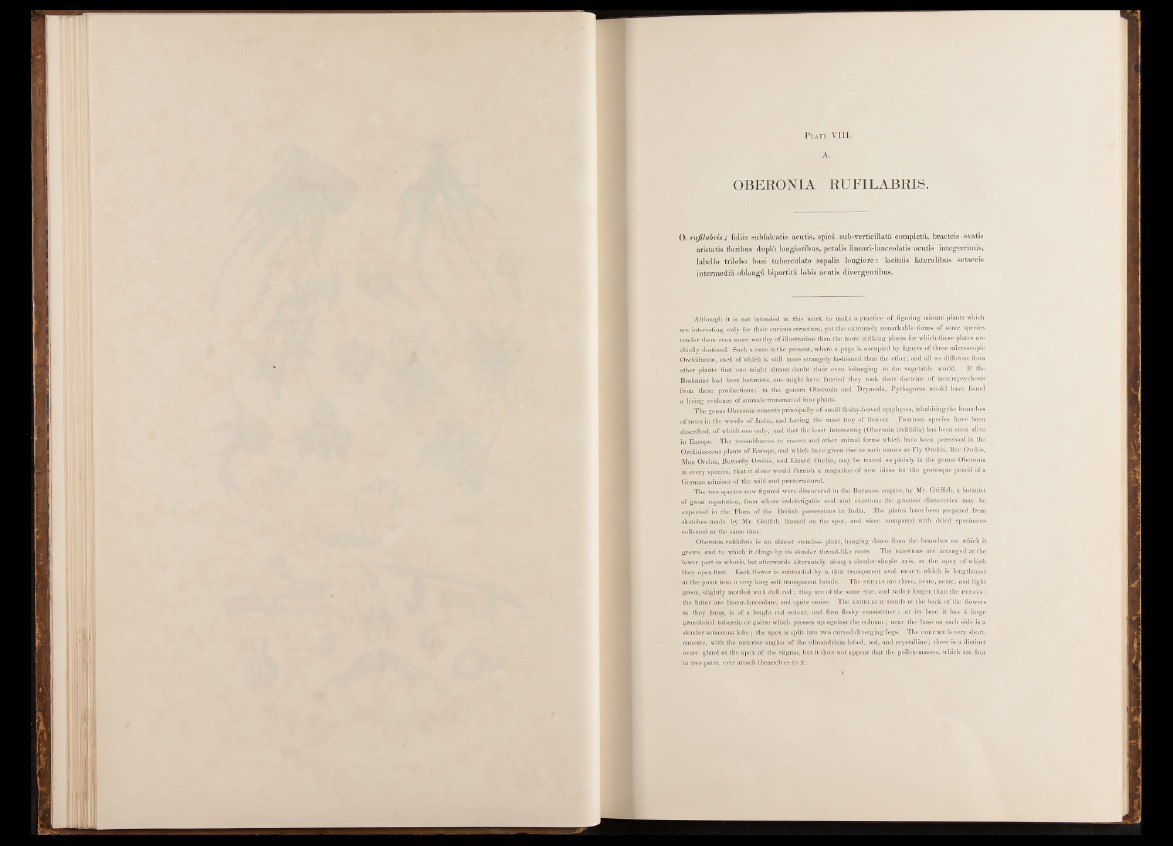
P late V III.
A.
OBERONIA RUFILABRIS.
O. rufilabris; foliis subfalcatis acutis, spica sub-verticillatS. complete, bracteis oyatis
aristatis floribus dupló longioribus, petalis lineari-lanceolatis acutis integerrimis,
labello trilobo basi tuberculato sepalis longiore: laciniis lateralibus setaceis
intermedia oblonga bipartite lobis acutis divergentibus.
Although it is not intended in this work to make a practice of figuring minute plants which
are interesting only for their curious structure, yet the extremely remarkable forms of some species
render them even more worthy of illustration than the more striking plants for which these plates are
chiefly destined.' Such a case; is the present, where a- page is occupied by figures of three microscopic
Orchidaceae, each of which is still more strangely fashioned than the other, and all so different from
other plants that one might almost doubt their even belonging to the vegetable world. If the
Brahmins had been botanists, one might have fancied they took their doctrine of metempsychosis
from these productions; in the genera Oberonia and Drymoda, Pythagoras would have found
a living evidence of animals transmuted into'plants.
The genus Oberonia consists principally of. small fleshy-leaved epiphytes, inhabiting-the .branches
of trees in the woods of India, and having the most tiny of flowers. Fourteen species have been
described, of which one only, and that-the least interesting (Oberonia iridifolia) has been seen alive
in Europe. The resemblances to insects and other animal forms which have been perceived in the
Orchidaceous plants of Europe, and which have given rise to such names as Fly Orchis,' Bed Orchis,
Man Orchis, Butterfly Orchis, and Lizard Orchis, may be traced so plainly in the genus Oberonia
in every species, that it alone would furnish a magazine of new ideas for the grotesque pencil of a
German admirer of the wild and preternatural.
The two species now figured were discovered in the Burmese empirej by.Mr. Griffith, a botanist
of great reputation,' from whose indefatigable zeal and- exertions the • greatest, discoveries may be
expected in the Flora of the British possessions in India. The plates have .been prepared-from
sketches made by Mr. Griffith himself on the spot, and since compared with .dried specimens
collected at the same time.
•^"..oJOberoma rufilabris is an almost stemless plant, hanging down 'from the branches on which it
grows, and to which it clings by its slender thread-like roots. The flowers are arranged at the
lower part in whorls, but afterwards alternately along a slender simple, axis, at the apex of which
they open first. Each flower is subtendedvby a thin transparent oval bract, which, is lengthened
at;the point.into a very long.soft transparent.bristle. The sepals are three,.ovate, acujte, and light
green, slightly mottled with dull red ; they are of the same size, and rather longer than the petals ;
the- hitter are linear-lanceolate, and• quite entire. . The labellum stands at the back of the flowers
as they hang, is of a bright red-colour, and firm fleshy .consistence; at its base it has a large
granulated tubercle or goitre which : presses up against the column ; near the base on each side is a
slender setaceous lobe ; the apex is split into two curved diverging legs. The column is very short,
cuneate, with the anterior angles, of the clinandrium lobed, red, and crystalline; there.is a distinct
ovate gland at the apex of the stigma, but it does, not appear that the pollen-masses, which, are .four
in two pairs, ever attach themselyes.tb.it. .